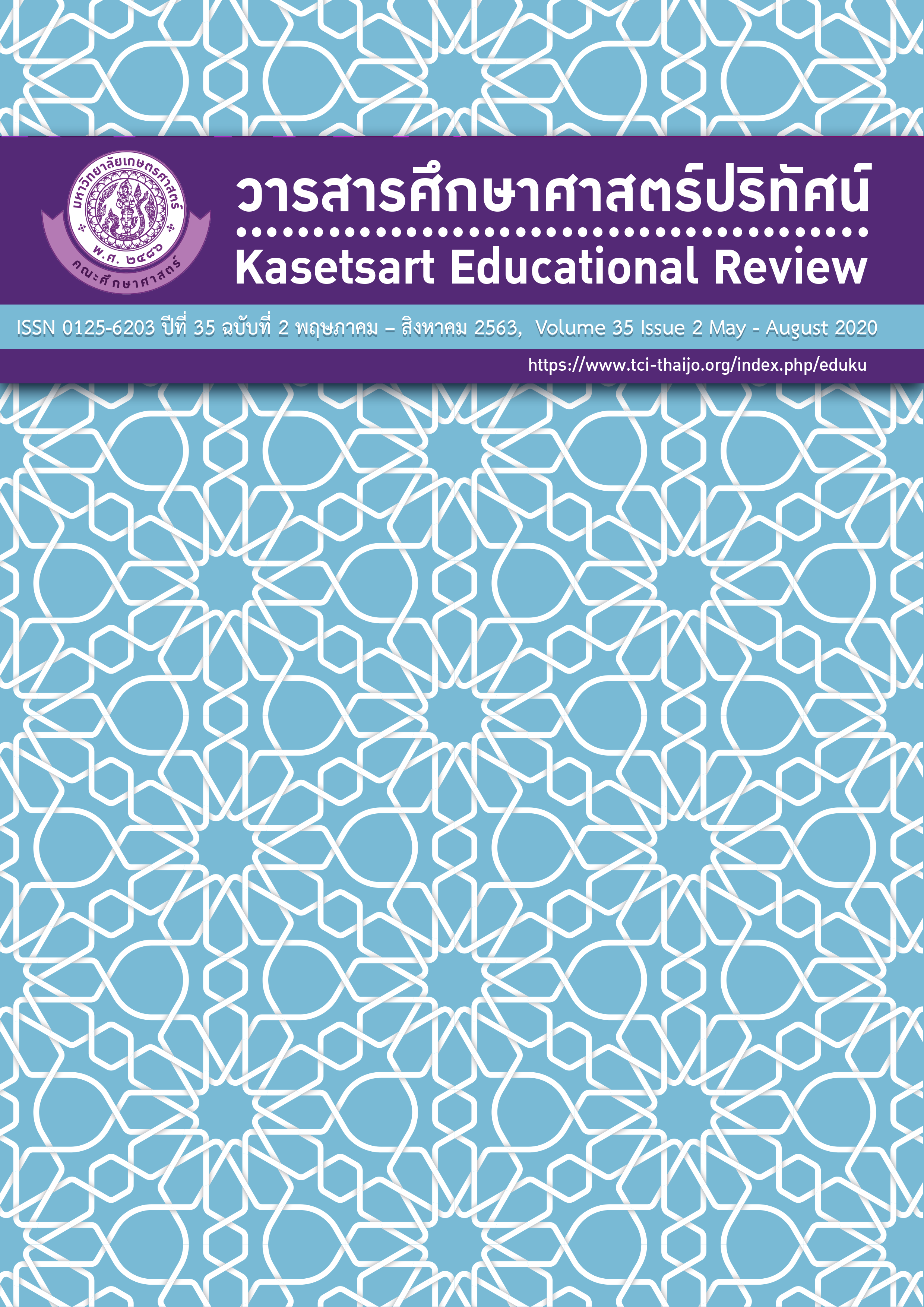การตรวจสอบเอกสารอย่างเป็นระบบและการวิเคราะห์อภิมานเรื่องวิธีการสอนแบบสืบเสาะหาความรู้ขั้นสูงเพื่อพัฒนาทักษะความคิดอย่างสร้างสรรค์ของผู้เรียน
คำสำคัญ:
การวิเคราะห์อภิมาน, ทักษะความคิดสร้างสรรค์, วิธีการสอนแบบสืบเสาะหาความรู้ขั้นสูงบทคัดย่อ
งานวิจัยนี้มีจุดประสงค์ เพื่อหาค่าอิทธิพลรวมของงานวิจัยที่ศึกษาผลของวิธีการสอนแบบสืบเสาะหาความรู้ขั้นสูงต่อความคิดสร้างสร้างสรรค์และเปรียบเทียบค่าอิทธิพลระหว่างงานวิจัยในกลุ่มต่าง ๆ ศึกษางานวิจัยที่ตีพิมพ์ในวารสารวิจัยระดับนานาชาติ ตีพิมพ์ระหว่างปี ค.ศ. 2009 จนถึง 2019 จำนวน 12 เรื่อง ตามเกณฑ์การคัดเลือกที่กำหนด คำนวณค่าดัชนีมาตรฐานสำหรับการวิเคราะห์อภิมาน ได้แก่ ค่าอิทธิพลและค่าความคลาดเคลื่อนมาตรฐาน ประมาณค่าอิทธิพลด้วยโมเดลอิทธิพลแบบสุ่มโดยใช้โปรแกรม R แพ็กเกจ meta และ metafor ผลการวิจัยระบุว่า ค่าอิทธิพลรวมมีค่าเท่ากับ 0.60 ตีความว่าการสอนแบบสืบเสาะหาความรู้ขั้นสูงมีอิทธิพลต่อการสร้างความคิดสร้างสรรค์ของผู้เรียนในระดับปานกลาง เมื่อดำเนินการวิเคราะห์กลุ่มย่อยพบว่า ค่าอิทธิพลรวมของกลุ่มตัวอย่างระดับประถมศึกษาและมัธยมศึกษามีค่าเท่ากับ 0.76 และ 0.53 ตามลำดับ และพบว่า งานวิจัยที่มีค่าอิทธิพลในเกณฑ์ระดับสูงมีลักษณะสำคัญ ได้แก่ ครูผู้สอนให้ผู้เรียนได้สืบค้นข้อมูล วางแผน ลำดับขั้นตอนและออกแบบวิธีการเพื่อจัดการกับงานหรือปัญหาที่ถูกกำหนดขึ้นมาหลากหลายรูปแบบหรือรูปแบบที่แตกต่างจากเดิมด้วยตนเอง โดยเฉพาะอย่างยิ่งงานวิจัยเหล่านี้มีการนำเทคโนโลยีหรือสื่อดิจิทัลเข้ามามีส่วนร่วมในการจัดการเรียนรู้ในห้องเรียน
เอกสารอ้างอิง
Arun. A. S.,Okere. M-I. O.&S.Wachanga.(2016). Influence of Culture and Gender on Secondary School Students’ Scientific Creativity in Biology Education in Turkana County, Kenya. Journal of Education and Practice, 7, 35
Astutik, S. & Binar, K.(2018). The Practicality and Effectiveness of Collaborative Creativity Learning (CCL) Model by Using PhET Simulation to Increase Students’ Scientific Creativity. International Journal of Instruction,11,409-424.
Atalay, N., & S.D. Boyaci.(2019). Slow-motion Application in Development of Learning and Innovation Skills of Students in Science Course. International Electronic Journal of Elementary Education, 11(5), 507-518
Bongkotphet, T.,& Roadrandka, V.(2010). Sixth grade science teachers' knowledge/belief of inquiry-based astronomy teaching. Journal of Humanities and Social Sciences Mahasarakham University,29(3),85–97.
Guilford, J. P. (1967). Creativity: Yesterday, today, and tomorrow. The Journal of Creative Behavior, 1(1), 3–14.
Harrer, M., Cuijpers, P., Furukawa, T.A, &Ebert, D. D. (2019). Doing Meta-Analysis in R: A Hands-on Guide.
Higgins JPT, & S. Green.(editors). Cochrane Handbook for Systematic Reviews of Interventions Version5.1.0 [updated March 2011]. The Cochrane Collaboration, 2011.Available from www.handbook.cochrane.org.
Hsiao, H., Chang, C., Lin, C., & P. Hu.(2014). Development of children's creativity and manual skills within digital game-based learning environment. J. Comp. Assisted Learning, 30, 377-395.
Hu, W., Wu, B., Jia, X., Yi, X., Duan, C., Meyer, W. &J. C. Kaufman.(2013). Increasing Students' Scientific Creativity: The “Learn to Think” Intervention Program. J Creat Behav, 47, 3-21. doi:10.1002/jocb.20
Institute for the Promotion of Teaching Science and Technology (IPST). (2009). Science Teaching Manuals. Bangkok: The Express Transportation Organization of Thailand.
Lin, K.-Y. (2014).Effects of science fiction films on junior high school students’ creative processes and products. Thinking Skills and Creativity, 14, 87–97.
Lin, K-L., Tsai, F-H., Chien, H-M., & Chang, L-T. (2013). Effects of a Science Fiction Film on the Technological Creativity of Middle School Students. Eurasia Journal of Mathematics, Science &Technology Education, 9(2), 191-200.
Lipsey, M., & Wilson, D. (2001).Practical meta-analysis. Thousand Oaks, CA: Sage. Mahalee, K., Faikhamta, C. (2010). Alternative: The development of seventh grade students’ understandings of nature of science through reflective explicit instructional approach. Songklanakarin Journal of Social Sciences and Humanities, 16(5), 795 –809.
McDonald, J.H., and K.W. Dunn. (2013). Statistical tests for measures of colocalization in biological microscopy. Journal of Microscopy 252: 295-302.
Nakagawa, S. & Cuthill, I.C. (2007). Effect size, confidence interval and statistical significance: a practical guide for biologists. Biological reviews of the Cambridge Philosophical Society, 82 (4), 591-605.
National Research Council.(2012). A Framework for K-12 Science Education: Practices, Crosscutting Concept, and Core Ideas. Committee on New Science Education Standards, Board on Science Education, Division of Behavioral and Social Science and Education. Washington, DC: National Academy Press.
Office of the Civil Service Commission (OCSC). (2016). Creative Thinking. Retrieved from https://www.ocsc.go.th/sites/default/files/document/ocsc-2017-eb13.pdf
Ozdemir, G. & Dikici, A. (2017). Relationshipsbetween scientific process skills and scientific creativity: Mediating role of nature of science knowledge. Journal of Education in Science, Environment and Health (JESEH), 3(1), 52-68.
Pakbongkot, C. (2011). Creative Thinking for Land: Creative Thinking - Sustainable Problem Solving. Bangkok: Pimdee Printing House.
Qureshi, S., Vishnumolakala, V., Southam, D.,& D. Treagust.(2016). Inquiry-Based Chemistry Education in a High-Context Culture: a Qatari Case Study. International Journal of Science and Mathematics Education.
Siew, N.M.; Chong, C.L. & B.N. Lee .(2015). Fostering fifth graders’ scientific creativity through problem-based learning. Journal of Baltic Science Education, 14, 655-669.
Schwarzer, G. (2007). “Meta: An RPackage for Meta-Analysis.” R News,7(3),40–45.
Viechtbauer, W. (2010). Conducting meta-analyses in R with the meta for package. Journal of Statistical Software, 36(3), 1-48. Retrieved from http://www.jstatsoft.org/v36/i03/
Wahyudi, W.; Verawati, N.-A., Syahrial & Prayogi, S. (2019). The Effect of Scientific Creativity in Inquiry Learning to Promote Critical Thinking Ability of Prospective Teachers. International Journal of Emerging Technologies in Learning (iJET),14, 122.
Wicaksono, I. & Wasis, Madlazim. W.-M.(2017). The effectiveness of virtual science teaching model (VS-TM) to improve student’s scientific creativity and concept mastery on senior high school physics subject. Journal of Baltic Science Education,16,549-561.
Yang, K.-K.; Lin, S.-F.; Hong, Z.-R. & Lin, H.-S. (2016). Exploring the Assessment of and Relationship Between Elementary Students’ Scientific Creativity and Science Inquiry. Creativity Research Journal,28,16-23. 10.1080/10400419.2016.1125270.
Yang, K-K.; Lee, L.; Hong, Z-R., H-S. Lin.(2016). Investigation of effective strategies for developing creative science thinking. International Journal of Science Education.
Yi. X., Plucker. A. P. &Gua J. (2015). Modeling influences on divergent thinking and artistic creativity, Thinking Skills and Creativity, 16, 62-68.
Yildirim, A.-L., Nail. (2016). The Effect ofContext-based Chemical Equilibrium on Grade 11 Students' Learning, Motivation and Constructivist Learning Environment. International journal of Environmental Science and Technology,11,3117-3137.
ดาวน์โหลด
เผยแพร่แล้ว
ฉบับ
ประเภทบทความ
สัญญาอนุญาต
บทความทุกบทความเป็นลิขสิทธิ์ของวารสารคณะศึกษาศาสตร์ มหาวิทยาลัยเกษตรศาสตร์ วิทยาเขตบางเขน
วารสารศึกษาศาสตร์ปริทัศน์ (Kasetsart Educational Review)






